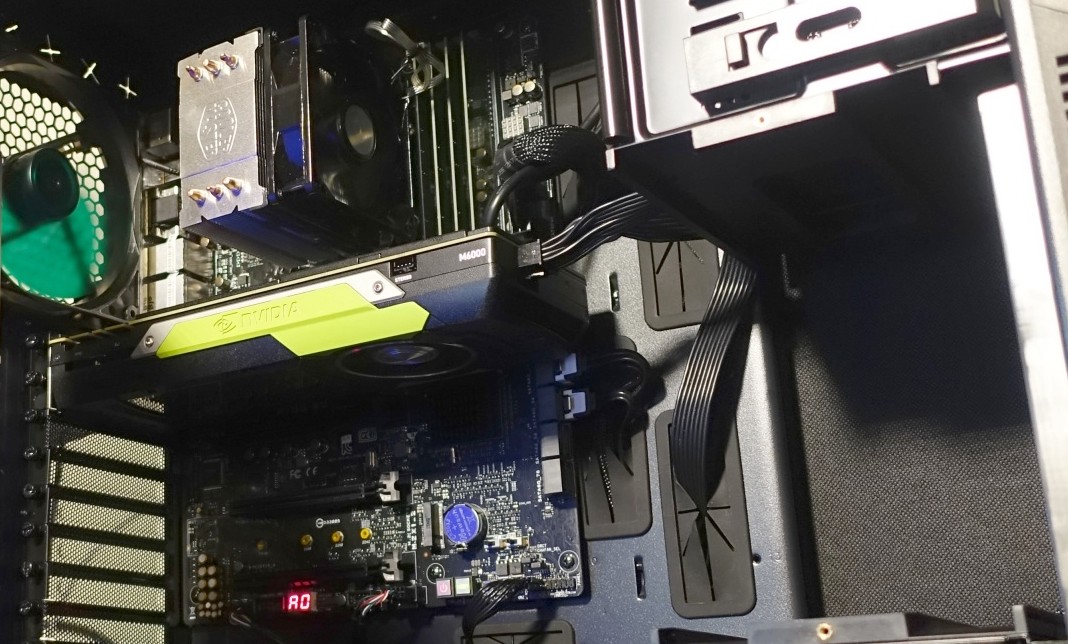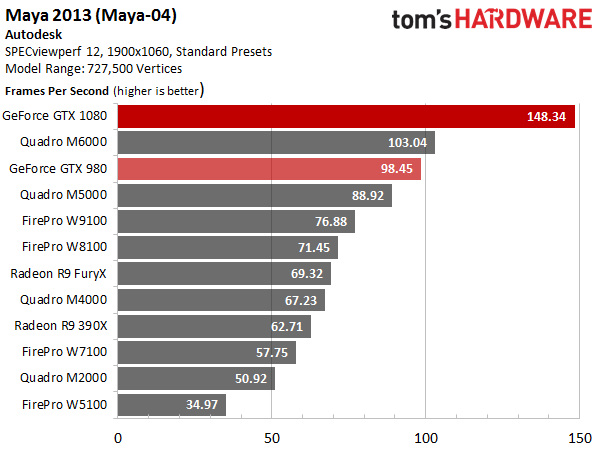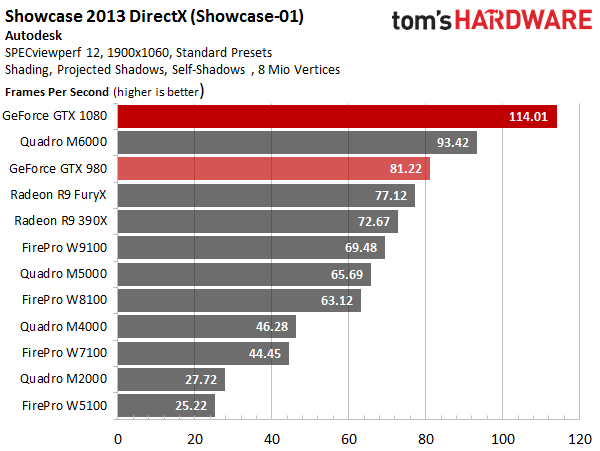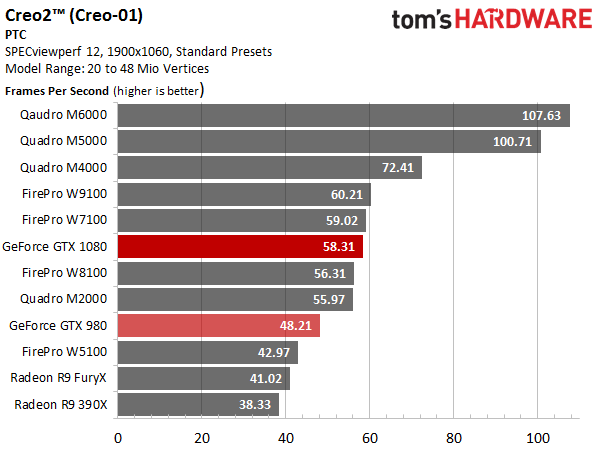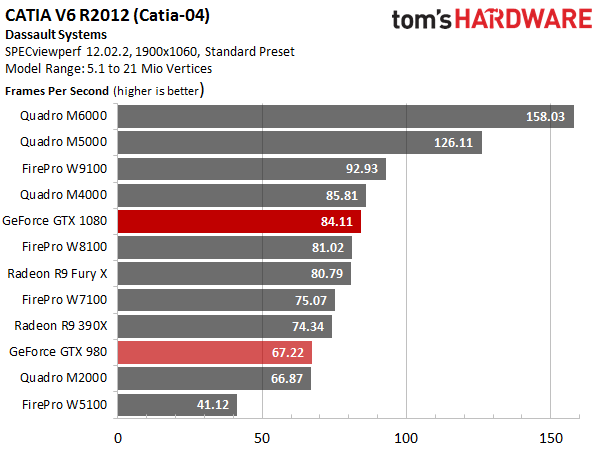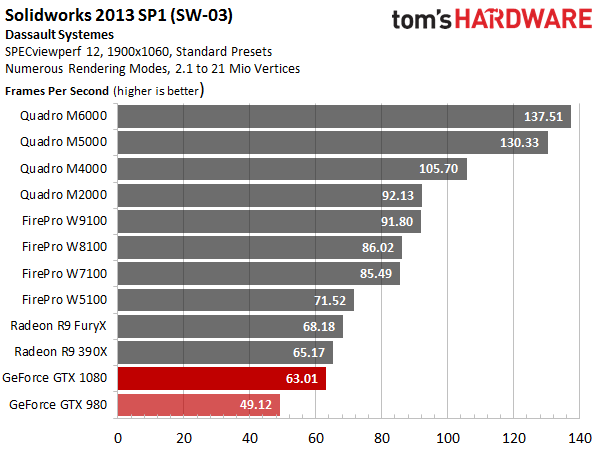Nvidia GeForce GTX 1080 Pascal Review
Professional Application Results
Our German team developed a “crossover” workstation in cooperation with the company Happyware in Hamburg. Since it's designed to represent actual workstation hardware, we're using workstation components. The CPU is a stock 3.7GHz Intel Xeon E3-1280 v5, which is the fastest Skylake-based workstation processor.
| Tom's Hardware Crossover Workstation | |
|---|---|
| Test System | Intel Xeon E3-1280 v5 at 3.7GHz 4x 4GB Kingston DDR4-2133 ECC Asus P10 WS 2x Samsung SM863 (3D V-NAND) Seagate Constellation Server HDD Windows 10 Enterprise (All Updates) |
| Drivers | Catalyst Pro 15.201.2401 Quadro ODE 362.56 WHQL (ODE Drivers) GeForce 368.13 (Press Drivers) |
Many of the professional applications we test require certified hardware and drivers, as well as workstation-class graphics cards. Then again, a growing number of companies, including Autodesk, have switched from OpenGL to DirectX. This means that there are some workstation-class apps you can run on desktop-oriented components for a lot less money. The following results provide a good overview of where this kind of setup can be expected to work, and what it looks like when it doesn’t.
AutoCAD 3D Performance
We’re focusing exclusively on AutoCAD’s 3D performance, since its 2D component is affected by host processing, rather than GPU capabilities. As usual, we’re using the Cadalyst benchmark and AutoCAD 2015.
Nvidia's GeForce GTX 1080 manages to beat the Quadro M6000 by approximately 2.5 percent. The true workstation card has the same GPU as a GeForce GTX Titan X, and it only operates 10MHz lower than the desktop version at its thermal limit. Then again, most cards finish fairly close to each other in this test since Intel's 3.7GHz Skylake-based CPU bottlenecks performance.
Maya 2013
The current version of SPECviewperf 12 includes an assortment of common business applications with fitting workloads. Its Maya test illustrates what happens when the GeForce GTX 1080 isn’t held back by some other platform component. A 44 percent advantage over the Quadro M6000 should translate to a similar advantage over GeForce GTX Titan X. The rest of the competition can’t keep up.
Showcase 2013
Showcase is another DirectX-based application. And while the GeForce GTX 1080’s advantage over Nvidia's Quadro M6000 (and, by extension, its GeForce GTX Titan X) isn’t as pronounced, a 22 percent advantage is nothing to dismiss. Its lead over the GeForce GTX 980 is a massive 40 percent, and that's in the face of a CPU bottleneck.
Creo 2
In contrast to what we've seen thus far, this application doesn't run well on gaming-oriented hardware. The GeForce GTX 1080’s performance isn’t horrible, but driver optimizations specific to the professional cards are plain to see this time around.
Get Tom's Hardware's best news and in-depth reviews, straight to your inbox.
Catia V6 R2012
The same goes for Catia, which puts desktop graphics cards at a huge disadvantage. Still, Nvidia's GeForce GTX 1080 performs well enough when price is a consideration.
SolidWorks 2013
The performance story takes another turn for the worse in SolidWorks 2013. Apart from the usual segmentation of professional and desktop graphics cards, SolidWorks specifically likes Quadro cards and crushes GeForces. At least AMD's drivers allow the Radeon cards to do a little bit of professional work; Nvidia's mercilessly stop this benchmark in its tracks. That's when buying a workstation graphics card for professional applications makes sense.
Current page: Professional Application Results
Prev Page The Division And The Witcher 3 Results Next Page Power Consumption Results-
JeanLuc Chris, were you invited to the Nvidia press event in Texas?Reply
About time we saw some cards based of a new process, it seemed like we were going to be stuck on 28nm for the rest of time.
As normal Nvidia is creaming it up in DX11 but DX12 performance does look ominous IMO, there's not enough gain over the previous generation and makes me think AMD new Polaris cards might dominate when it comes to DX12. -
slimreaper Could you run an Otoy octane bench? This really could change the motion graphics industry!?Reply
-
F-minus Seriously I have to ask, did nvidia instruct every single reviewer to bench the 1080 against stock maxwell cards? Cause i'd like to see real world scenarios with an OCed 980Ti, because nobody runs stock or even buys stock, if you can even buy stock 980Tis.Reply -
cknobman Nice results but honestly they dont blow me away.Reply
In fact, I think Nvidia left the door open for AMD to take control of the high end market later this year.
And fix the friggin power consumption charts, you went with about the worst possible way to show them. -
FormatC Stock 1080 vs. stock 980 Ti :)Reply
Both cards can be oc'ed and if you have a real custom 1080 in your hand, the oc'ed 980 Ti looks in direct comparison to an oc'ed 1080 worse than the stock card in this review to the other stock card. :) -
Gungar @F-minus, i saw the same thing. The gtx 980Ti overclocks way better thn 1080, i am pretty sure OC vs OC, there is nearly no performance difference. (disappointing)Reply -
toddybody Reply@F-minus, i saw the same thing. The gtx 980Ti overclocks way better thn 1080, i am pretty sure OC vs OC, there is nearly no performance difference. (disappointing)
LOL. My 980ti doesnt hit 2.2Ghz on air. We need to wait for more benchmarks...I'd like to see the G1 980ti against a similar 1080. -
F-minus Exactly, but it seems like nvidia instructed every single outlet to bench the Reference 1080 only against stock Maxwell cards, which is honestly <Mod Edit> - pardon. I bet an OCed 980Ti would come super close to the stock 1080, which at that point makes me wonder why even upgrade now, sure you can push the 1080 too, but I'd wait for a price drop or at least the supposed cheaper AIB cards.Reply -
FormatC I have a handpicked Gigabyte GTX 980 Ti Xtreme Gaming Waterforce at 1.65 Ghz in one of my rigs, it's slower.Reply
